Techno Warfare 2035: United States Army War College Class of 2023 – Cyborgs, Genetic Engineering, Brain Computer Interface, Mind Control, AI Automated Targeting Weapons Systems

Many people around the world have no concept that they are in the middle of a neuro cognitive war empowered by electromagnetic frequency weapons, nanotechnology and synthetic biology based weapons of mass destruction and mind control. They look to the captured allopathic healthcare system peer review literature – a health care system that does not know it has been weaponized for a transhumanist depopulation agenda. This is why I continue to post military materials which explains their understanding of warfare. Any of the previously covered documents like Cyborg Solider 2050 have dates that are misleading to the public associated with them. All of the technologies mentioned are operational now and deployed against civilians at this time.
Read for yourself and educate yourself as to the current technological capabilities of science and our military.
Cyborg Soldier 2050: Human/Machine Fusion and the Implications for the Future of the DOD
I am posting this paper because people need to understand how our military has moved forward on studying the creation of Cyborg Human Machines. It discusses that the health care system will get society used to human machine augmentation. Remember that Sasha Latypova explained much about the connections of the Department of Defense and the C19 injection …
Who wrote the document?
The researchers on Team Techno-Warfare Group prepared this report as a group Strategic Research Project as part of the requirements to complete the Master of Strategic Studies degree from the United States Army War College (USAWC). This document’s research, analysis, and preparation were conducted from October 2022 through May 2023. This report answers a strategic question posed by Mr. Thomas F. Greco, Deputy Chief of Staff, G-2, U.S. Army Training and Doctrine Command, based on open-source information and interview with subject matter experts.
Background information tells you your mind is the battlespace – automated warfare executed by AI is what targeted individuals have been experiencing for decades:
Intelligentized warfare, as conceptualized in China’s National Defense in the New Era (July 2019), will highly likely (71-85%) evolve into a new type of warfare that can be best described as Techno-sentient warfare by 2035. Enabled by quantum computing and cutting-edge artificial intelligence, Techno-sentient warfare will be comprised of a fusion of space, cyber, and cognitive influence operations conducted below the threshold of armed conflict and throughout combat operations leading to systems clashes and partially automated warfare. To prevail in this new era, it is almost certain (86-99%) leaders will need to cultivate a functional understanding of emerging technologies, master the intricacies of the artificial intelligence decision-making processes, and develop a sophisticated comprehension of big data-driven AI solutions. This expertise will be crucial for fostering trust in these consequential systems across tactical, operational, and strategic levels, empowering the leaders of 2035 to adopt a resilient mindset that prioritizes innovation.
The themes are everything I have been speaking about and am already seeing in the human blood – autonomous drone swarms ( can be on a nanoscale), Brain computer interfaces ( via bidirectional telemetry sensors), Gene editing, CRISPR and parasitical enhancement drugs ( I would put the C19 into that catetgory:
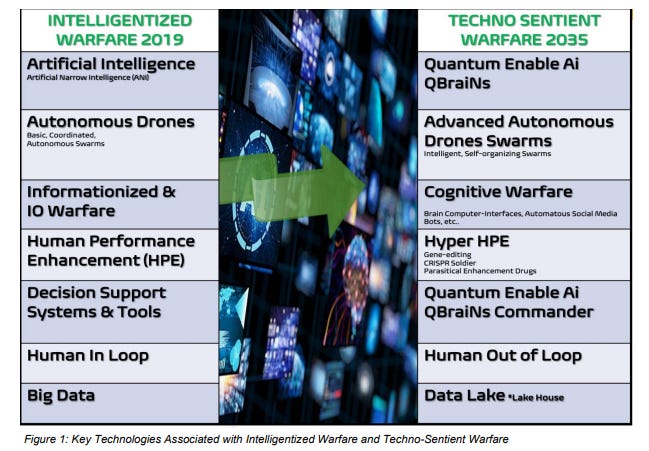
Cornell University Quantum computer brain interface for DISRUPTIVE TECHNOLOGIES:
Basic Artificial Narrow Intelligence to Quantum Brain Networks (QBraiNs):
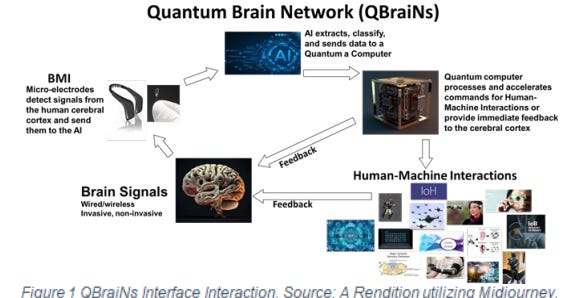
Since 2019, artificial narrow intelligence (ANI) has advanced in a parabolic fashion. Increased availability of large-scale datasets has propelled unexpected AI advancements that include the development of sophisticated deep learning algorithms leading to the widespread adoption of AI in multiple industries. The advent of quantum computing promises to propel AI capabilities to new levels. Quantum computing uses principles of quantum mechanics to perform computations that traditional computers cannot. It utilizes quantum bits (qubits) that can exist in multiple states simultaneously, allowing for parallel processing and exponentially faster computations than classical computers. Quantum Brain Networks (QBraiNs): Quantum Brain Networks (QBraiNs) is a new interdisciplinary area of study described by Cornell University as integrating knowledge and methods from neurotechnology, artificial intelligence, and quantum computing. The objective is to develop enhanced connectivity between the human brain and quantum computers for various disruptive applications. QBraiNs technology aims to use a brain-machine interface (BMI) to 7 create a computing platform that can help individuals analyze complex data sets and detect patterns or anomalies to support rapid decision-making in real-time.
The subject of this cognitive warfare is YOU:
Informationized and IO Warfare to Cognitive Warfare: Informationized and IO warfare refers to using information technology and communication networks to gain a strategic advantage in military operations by disrupting or manipulating the enemy’s information systems and influencing their decision-making processes. Cognitive Warfare will focus on influencing and manipulating the thoughts, beliefs, attitudes, and behaviors of targeted individuals or groups using psychological tactics such as propaganda, disinformation, and other forms of brain manipulation. It aims to gain a decisive advantage over the opponent by controlling human behavior’s mental and emotional aspects, otherwise known as the cognitive domain.
Genetically modified Cyborgs are always part of the picture “Hyper Human Performance Enhancement” and transition out of human oversight:
Human Performance Enhancement (HPE) to Hyper Human Performance Enhancement: Previous human enhancement used pharmaceuticals, nutritional supplements, and wearable technology to increase human output. As warfare transitions from Intelligentized warfare to Techno-Sentient warfare, HPE will advance to Hyper HPE. At the core of Hyper HPE is the application of Clustered Regularly Interspaced Short Palindromic Repeats (CRISPR) technology, which relies on genome editing technology to enhance human performance. Decision Support System and Tools to QBraiNs Commander: The 2019 version of decision support systems and tools relied on a laborious process, including analog procedures and a robust staff to develop options before making decisions. Team Techno Warfare Group’s (TWG) research points towards a transition to what may be known as a QBraiNs CDR. The application of QBraiNs for commanders and essential staff will enable decisive and rapid decisions.
Human-In-The-Loop to Human-Out-Of-the-Loop – machines will engage without human intervention:
This transition highlights the anticipated need to shift from continuous human oversight in offensive and defensive systems to a forecasted need to rely upon, in some instances, automatic machine or system reactions. Human Out of the Loop (HOOL) operations are often synonymous with autonomous or ‘full autonomy.’ DOD Directive 3000.09 defines autonomous weapon systems as “a weapon system that, once activated, can select and engage targets without further intervention by an operator.”
Big Data Transition to Data Lakes – means total automated surveillance via AI done by Microsoft:
The manual collection and processing of large amounts of structured and unstructured data will transition to Data Lakes. Microsoft defines Data Lakes as a repository that stores large amounts of data in its original form and can handle all data types from any source. The data is stored in staged zones for various user needs and can power big data analytics, machine learning, and predictive analytics.
Techno-Sentient Warfare:
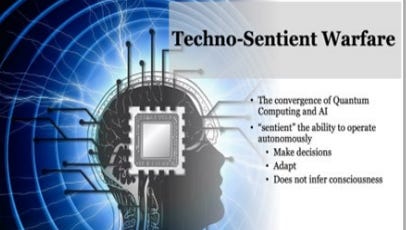
It is highly likely (71-85%) that nations with advanced technologies will employ Techno-sentient warfare by 2035. Techno-sentient warfare incorporates quantum computing and advanced artificial intelligence (in the spectrum between artificial narrow intelligence and artificial general intelligence) to augment emerging technologies supporting semiautomated warfare. The term “sentient” in Techno-Sentient Warfare refers to the AI’s ability to operate autonomously, make decisions, and adapt to new circumstances; it is not necessarily inferring that the system has consciousness.
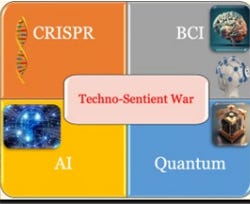
Revolutions in Military Affairs by Targeting Individuals through automated psychological assaults and via enhanced Cyborg Soldiers:
According to Rand Hundley in a 1999 Rand Corporation research brief, a revolution in military affairs is defined as “a paradigm shift in the nature and conduct of military operations that either renders obsolete or irrelevant one or more core competencies of a dominant player, creates one or more new core competencies in some new dimension of warfare, or does both.” It is almost certain (86-99%) that the convergence of the previously described disruptive technologies will lead to the emergence of individually operated and autonomous drone swarms, resulting in a revolution in military affairs (RMA) by 2035. Gene-edited, technologically enhanced soldier capabilities are also highly likely (71-85%) to be developed to the point that it will revolutionize small squad capability in special operation units by 2035. Finally, it is highly likely (71-85%) that cognitive social media warfare will reach a level commensurate with an RMA. Coordinating the use of information, space, and cyber capabilities, state and non-state actors operating in the grey zone will seek to manipulate the thoughts and actions of targeted individuals or groups through automated psychological assaults.
Here is the education these military leaders are already given – all AI controlled.
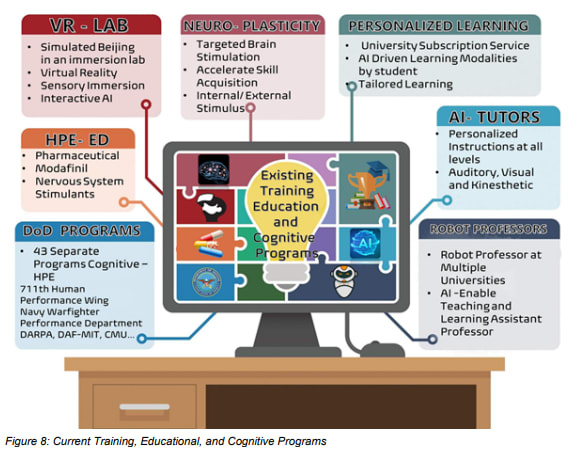
Universities such as the Kanda University of International Studies in Japan and the Unitec Institute of Technology in New Zealand have used immersive technologies such as virtual reality (VR) and augmented reality (AR) to enhance language learning and to provide interactive education. Additionally, students at Rensselaer Polytechnic Institute in New York used their immersion lab to master Mandarin about twice as fast as their peers. Major universities such as Georgetown and MIT have explored neuroplasticity methods to accelerate skill adaptation and medical institutions have used similar methods to enhance treatment protocols to help motivate patients. Several universities are experimenting with personalized learning, including 15 subscription-based programs that use AI tutors and teaching assistants to facilitate interactive education, even without a human instructor. Philipps University of Marburg, Germany is the first to employ a full-time robot lecturer named Yuki. The DoD may benefit from exploring some of these disruptive education models to improve future training and education.
Manipulating The Mind Weaponized Neuroscience is Highly Likely to Become the Dominate Cognitive Warfare Strategic Weapon by 2035

Intelligentized warfare1 is China’s approach to achieving dominance by incorporating emerging technologies such as A.I., cloud computing, big-data analytics, quantum information, IoT, advances in uncrewed systems, and weaponized neuroscience. Weaponized neuroscience, a critical emerging component of intelligentized warfare, utilizes cognitive warfare to gain control over people’s thoughts and actions. The modern battlefield is expanding, and the human brain may become the next battleground for the 21st century. It is highly likely (71-85%) that cognitive warfare will become the primary strategic weapon system by 2035, with China’s Strategic Support Force (SSF) poised to dominate. The SSF is projected to divide cognitive operations into four categories: bilateral exchanges, biological human performance enhancement, weaponized neuroscience, and disinformation spread by autonomous social media bots. As countermeasures, Allied defense sector leaders must invest in AI-driven detection tools and cybersecurity initiatives to combat advanced AI-driven bots, secure and efficient BrainComputer Interfaces (BCIs), and address ethical concerns surrounding the use and weaponization of neuroscience. Biological human performance enhancement and human performance enhancement drugs are also expected to augment soldiers’ physical and cognitive abilities, urging defense leaders to explore their own research in ethical human performance enhancement technologies and develop strategies for confronting enhanced adversaries.
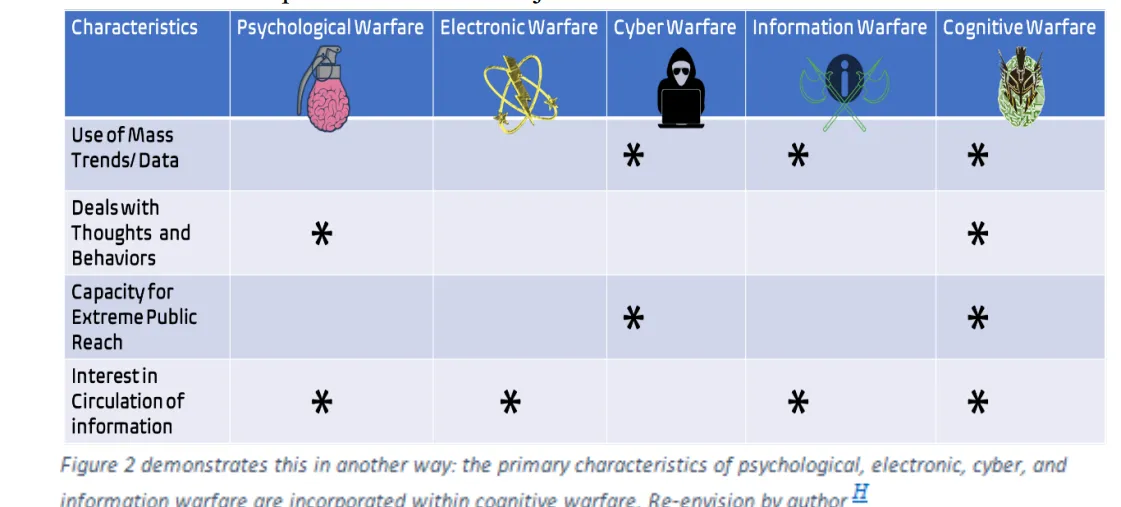
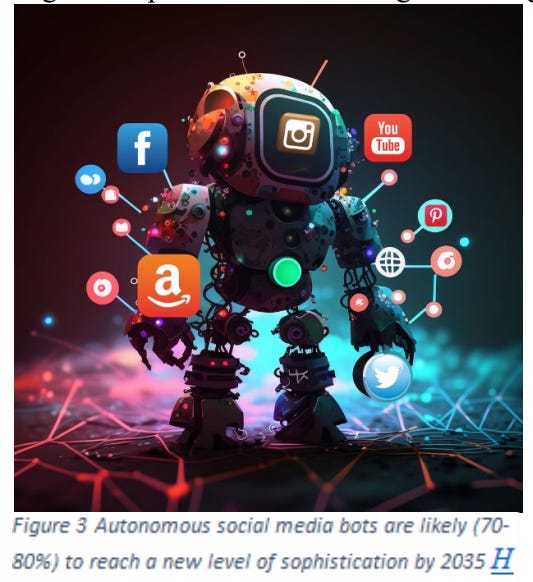

The recent Quantum computer can perform calculations Millions of times faster than a supercomputer.
The U.S. and Canada pioneered the deployment of working quantum computers, with China recently becoming the third nation to deliver its “Wuyuan” quantum computer .MM Furthermore, IBM is working with Mercedes-Benz, ExxonMobil, CERN, and Mitsubishi Chemical on implementing quantum computing to improve their respective processes and services in electric vehicles, data processing for the Large Hadron Collider, and improving transit routes.

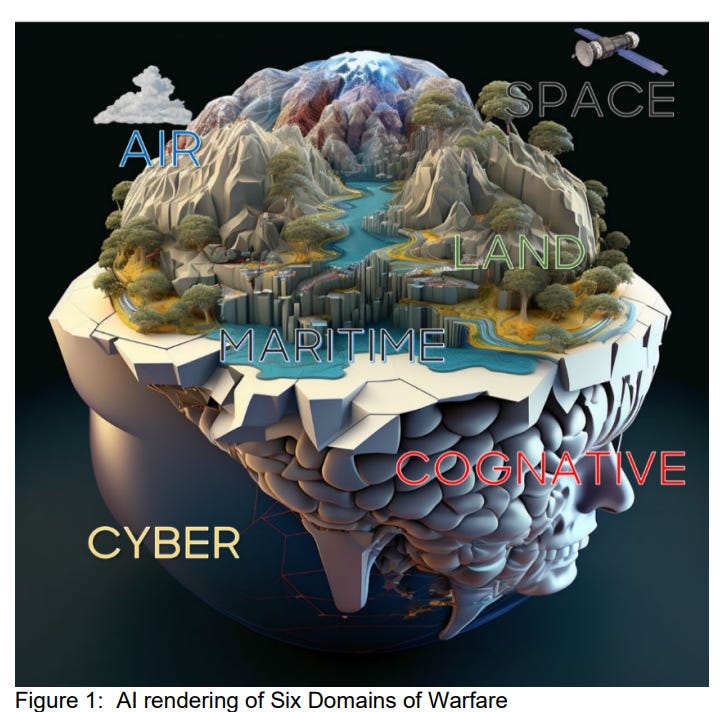

The term brainwashing came into existence in the 1950s, and its meaning has evolved. It has raised new concerns about psychological warfare and manipulating the mind with artificial intelligence and computer data mining. Coercive persuasion is a psychological technique used to manipulate an individual’s beliefs, thoughts, and behavior. Brainwashing has been used throughout history, from the WuChu wars, WWII, Vietnam. One of the most well-known events of brainwashing in warfare occurred during the Korean War when POWs were subjected to physical and emotional abuse and signed confessions for crimes they did not commit. The emergence of new technology, the global reach of the internet, and the use of social media have made it easier than ever to spread disinformation and sway public opinion due to the inability to censor propaganda in a free democracy. Social media is the most popular activity globally, with over 4.26 billion people using it, and projected to increase to 6 Billion in 2027.
Peer pressure is a weapon. The allopathic and scientific system is riddled by this mode of mind control – its called “peer reviewed.” Social media brain washes the masses:
Adult judgments are malleable to group pressure, and less than one-third of people studied can resist this. Just being part of a group influences judgment, perception, and pressure. The internet and social media have positive and negative effects, and every trigger and stimulus leaves traces in the brain. Using neurofeedback, rhythmic sound, or flashing lights, the neural activity of the brain can be modified. AI uses various information-processing techniques, including natural language processing, machine learning, and data mining. The future of AI in social media is analyzing individual personality traits, likes, interests, and political affiliations and targeting those traits to sway personal thoughts and behaviors in a different direction. For example, AI can use Facebook likes and digital footprint data to determine intelligence, political view, personality, happiness, and more. It is highly likely that by 2035, AI will be able to analyze this data and target individuals to sway political views or beliefs and even elections. Attitudes are formed through direct experience or the persuasion of others and can be changed through operant or classical conditioning. Through the use of repetition, sounds, music, and colors, advertisers have been using techniques similar to brainwashing to build associations in the brain to retain information it would not normally retain. With the assistance of AI and social media, individuals will be targeted through a more narrow scope to sway beliefs and values through subliminal messages. Operant conditioning can reinforce or discourage a belief or idea by making it a positive or negative experience. The conditioned thoughts or positive behaviors are repeated, and negative ones diminished. Neuroscientists are using brain imaging combined with artificial intelligence and machine learning to analyze the complex electrical activity of the brain. They can decipher what a person is thinking and feeling. The ability to examine and change the electrical activity in the brain promises to do for the brain what biochemistry did for medicine.
___
https://anamihalceamdphd.substack.com/p/techno-warfare-2035-united-states?

